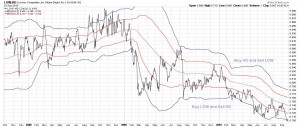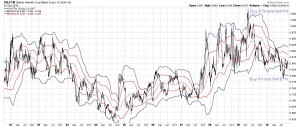Update: The post was included in the 280th Carnival of Personal Finance
Statistical Arbitrage Pairs Trading. That’s the topic of our interview today. While you may have heard of simple pairs trading which involves going long one security and going short another, it’s the statistical arbitrage aspect that you’ll be introduced to today. Our interviewee is a highly accomplished mathematician and trader and approaches investing from a strictly quantitative standpoint. Not only will you find examples of statistical arbitrage pairs trades but you’ll also be introduced to a few free tools that the interviewee has made available to all investors to help them manage their portfolios better. Enjoy.
Biography: Michael Kapler is a Portfolio Manager at SciVest Capital Management, where he previously worked as a Quantitative Analyst from 2003 to 2005. He has over ten years of experience in investment industry, most recently as a Portfolio Manager at Quant Investment Strategies, a Canadian hedge fund specializing in relative value strategies. Prior to that he held the position of Portfolio Manager, Asset Allocation Portfolios, at Manulife Financial Corp. Global Investment Management, where he was responsible for the design and development of new asset allocation products and tactical asset allocation methods and models. Mr. Kapler is a CFA charter holder, and holds a Master of Mathematical Finance (MMF) and a Bachelor of Science in Economics and Computer Science from the University of Toronto.
Q: Michael, can you tell us a little bit about your role at SciVest and the strategies you employ?
A: At SciVest, I run the statistical arbitrage pairs trading strategy, monitor current events, as well as research and back test new investment ideas. I also advise on the global country asset allocation model that uses combination momentum and mean-reversion to allocate funds to different country models. I approach money management in a quantitative way: I want to know what the risks are and how I can hedge the downside and profit from the upside.
Q: Can you elaborate a little on your pairs trading strategy? How do you generate the trade ideas? Do you trade pairs in the same sector? What are the metrics you look at to go long and what are the metrics you look at to go short?
A: The pairs trading strategy is a market neutral trading strategy where one can profit in any market conditions, at least theoretically. I have created a computer program that compares all companies in the same economic sectors and generates potential pairs candidates. This program looks for a Statistical cointegration in a pair, which is a long-term measure of dependence that guarantees that the two stocks cannot diverge for very long time without coming back together eventually. Statistical cointegration is sometimes confused with correlation; however, the statistical cointegration does not necessarily imply a high correlation. A high correlation implies that the two stocks have to move in synchrony over short-term but does not guarantee that the two divergent stocks will come together in the long run.
When selecting a pair from the program generated list, I compare price, market capitalization, fundamental ratios, and technical indicators for each stock. I apply the same set of rules equivalently across all stocks, regardless of whether they are short or long positions. For example, both companies should be similar in size and price. I would not want to have a pair where I am trading large cap stock vs. small cap stock; similarly I would not want to trade a $5 stock vs. a $50 stock. Next, I look at fundamental ratios: P/E, P/B, sales growth, debt levels, and dividends to check for any significant differences between the stocks in a pair. Lastly, I examine the current technical picture and news for each stock to make sure that there are no big gaps in the recent price history and there are no big changes on the horizon.
For example, having as a part of a pair a Healthcare company waiting for a FDA approval or a volatile Technology stock with an upcoming earnings report can be very risky.
Q: What is your approach to managing risk (and how do you implement this in your fund – stop losses, position sizing etc)?
A: I approach risk management for the pairs trading strategy from the bottom up perspective. First, I focus on the stocks in each pair being from the same economic sector and engaging in a similar business activity. I also check for stock metrics, news, and developments to hedge against potential factors that might hinder pair effectiveness. Performing these analyses gives me confidence that external shock will affect both stocks in a pair in the similar way; thus, I do not normally use stop losses and prefer to have equal amounts invested in each stock.
Furthermore, I diversify across pairs and across economic sectors. The portfolio usually contains from 40 to 50 pairs with at least 5 pairs representing each sector. The portfolio is also diversified across economic sectors with no more than 30% of money allocated to any particular sector.
Finally, I constantly monitor and update the pairs portfolio. I close a pair once it has converged to the long-term mean and replace it with a new pair. I also close pairs if there are important new developments to one or both stocks in a pair; for example, a merger or a significant buyback.
The final portfolio developed in this manner is robust to general market shocks, because stocks in each pair respond to economic events in a similar way. Moreover, the diversification across pairs in the sector and across sectors makes this portfolio resilient to specific company events.
Q: Does asset allocation or things like value/growth or the stage of the business cycle work into your strategies at all?
A: The asset allocation plays a key role in my strategies. For example, for the pairs portfolio I allocate capital to different economic sectors based on the recent pairs performance and historical win/loss ratio for a given sector. For the global country asset allocation model, I look at the combination of short and medium term momentum and mean-reversion to allocate funds to different country models.
Q: Can you please go into detail (metrics involved, target prices/ stop losses, risks) on 1, maybe 2 examples of pairs you have in the portfolio currently?
A: Let’s have a look at two home improvement companies: The Home Depot (HD) and Lowe’s (LOW). These are very liquid large cap stocks that offer comparable services and are affected by similar economic factors. These stocks are also similar in their fundamental ratios: P/E, P/B, Sales growth, Debt levels, and Dividends. Let’s examine a spread chart. A spread chart, plots a ratio of LOW price to HD price (black solid line), and overlays two Bollinger bands indicators with one and two standard deviations (red and blue solid lines respectively) above and below 130 day moving average (red dotted line).
Currently the spread (solid black line) is touching the two standard deviation band (blue solid line) because HD stock performed better relative to LOW. In this situation, I would have a long position on LOW and short position on HD, fully expecting the spread to go back to the mean, a 130 day moving average (red dotted line).
The essence of the pairs strategy is to open a pair when it is at the two standard deviation band and close a pair once it reaches a 130 day moving average.
Another example of a pair (from the Industrial sector) that I had in the portfolio this August was Eaton (ETN) and Parker Hannifin (PH).
Q: You’ve also created some very helpful applications that investors can download for free from your website, Michael – what was the impetus behind the creation of these tools?
A: I created a few applications that investors can download for free from my website (http://kapler.yolasite.com/) because I wanted to share simple tools that might be of interest to both professionals and personal investors. These tools are basic in nature but can be useful and fun in examining different financial problems. I tried to make these applications straight forward and user friendly so even a beginner investor would be able to make use of them. I encourage anyone who has piqued an interest in the topic to download an application and experiment.
Q: How did you imagine these tools to be used? In other words, since most investors are either passive mutual fund or ETF investors, how do you think they should take advantage of the tools you’ve made available to them?
A: I believe that the applications that I have developed have a number of uses. For example, one can use the Seasonality Analysis Tool to investigate when was a good time to buy/sell a stock or an ETF. Seasonality Analysis program uses historical data to identify the best and the worst months for a given stock or an ETF. An investor can time the purchase and sale based on this information. Please be aware that these statistics are based on the historical information only and there are no guarantees that the past is a good predictor of the future. For instructions and example on how to use this tool, please have a look at the tutorial on my website that explores Wal-Mart’s stock with the Seasonality Analysis tool.
For a passive investor, I envision that the Efficient Frontier Tool will be the most useful. This is an asset allocation tool that can help an investor to find an optimal investment mix. The program computes mean-variance efficient frontier (risk/return optimal portfolios) given input assumptions and constraints, and presents the user with detailed statistics for optimal portfolios. The investor can compare the current portfolio to the optimal portfolios to determine current risk/return profile and whether rebalancing is necessary.
Q: Michael, what are your thoughts on averaging down? For example, let’s say one has $4 to invest. If the price of the instrument you are going to buy drops to $2, though you expect it to eventually revert to $3, do you spend your entire $4 when the price is at $2 or maybe spend 50% at $2 and wait for the price to possibly drop to $1 and then average in your remaining 50%?
A: I subscribe to the asset allocation philosophy, where it is common to sell “winners” and buy “losers” to move allocation back toward original targets during portfolio rebalancing. This process averages down the cost of the losers. During quarterly rebalancing the portfolio manager may add up to 5% to the “losers”. However, investing 50% now and 50% later to average down is a bit excessive.
Thank You, Michael!
{ 3 comments }









